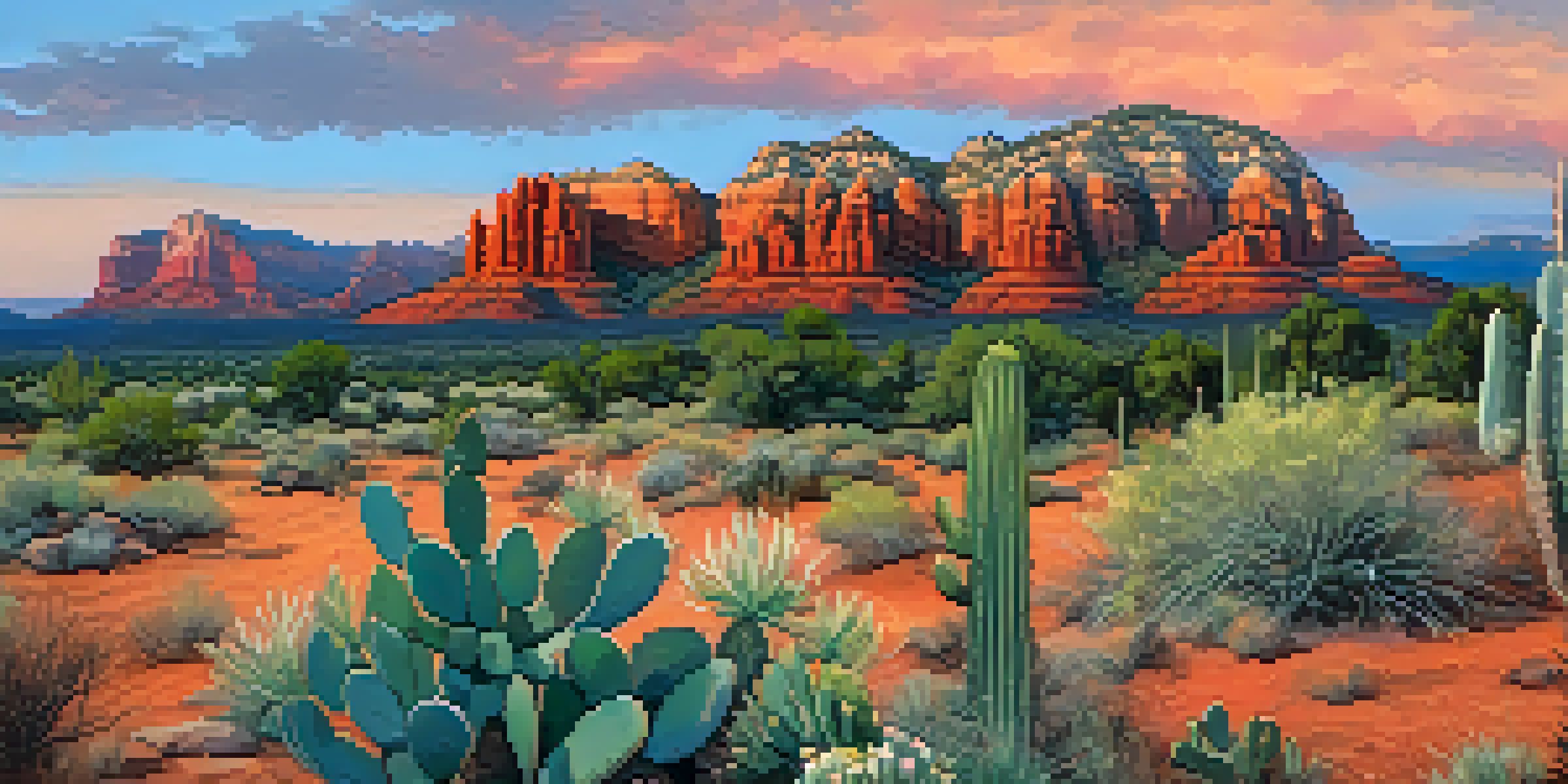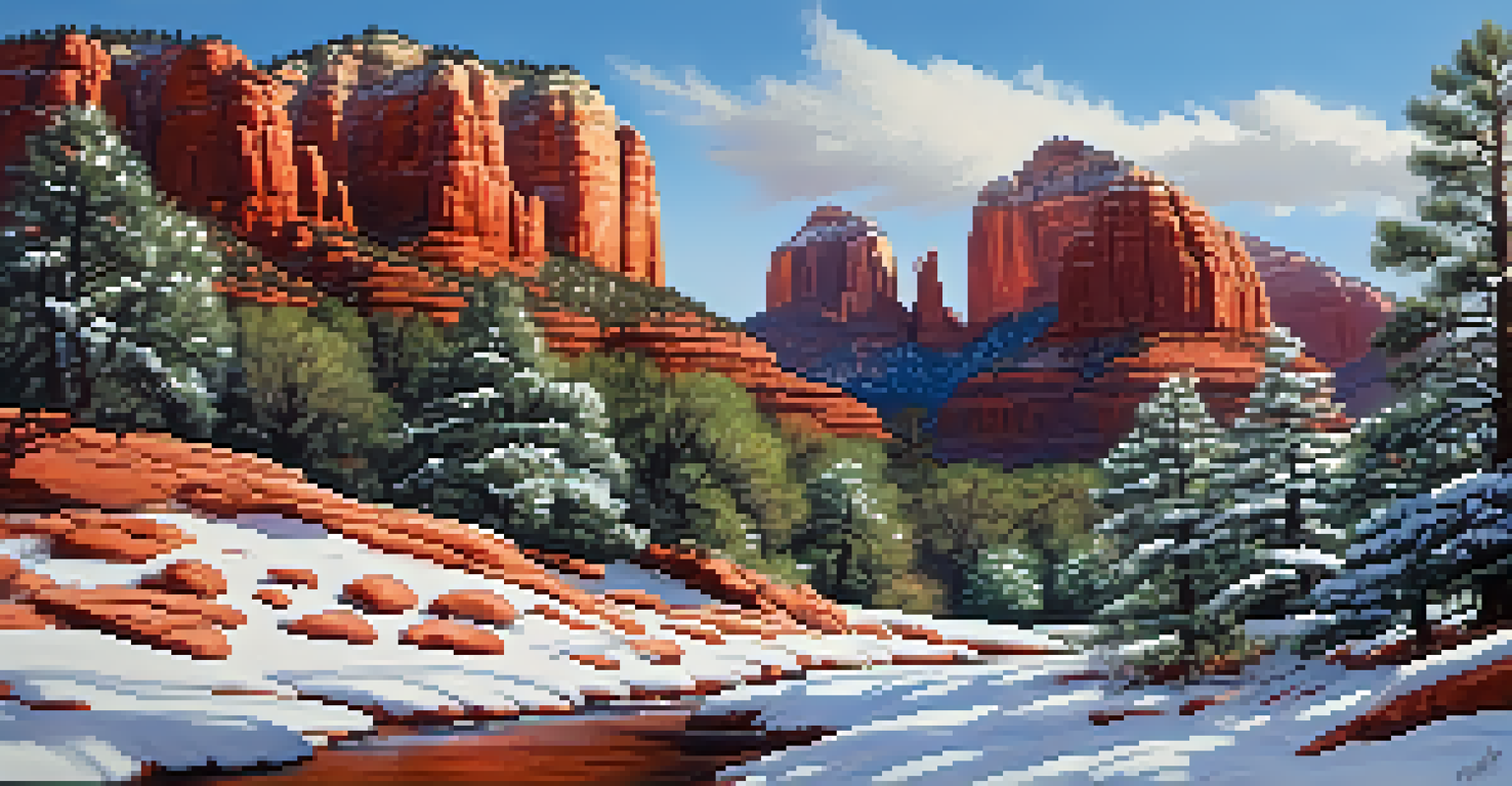Exploring Sedona's Seasonal Weather Variability and Trends

Understanding Sedona's Climate Zones and Elevation
Sedona is known for its stunning red rock formations, but its weather can be just as captivating. The city sits at an elevation of around 4,500 feet, which creates a unique climate that varies significantly by season. This means that while the valleys may bask in sunny warmth, the higher elevations can be much cooler, often surprising visitors who may not expect such variability.
The mountains are calling and I must go.
Generally, Sedona experiences a semi-arid climate, characterized by hot summers and mild winters. However, the proximity to the Colorado Plateau influences this weather, leading to cooler temperatures and occasional precipitation, especially during the monsoon season. In essence, understanding these geographical influences helps explain why Sedona's weather is anything but predictable.
To truly appreciate Sedona's climate, it's essential to consider how elevation and geography work together to create diverse weather patterns. This interplay not only impacts daily life but also shapes the stunning landscapes, making each visit a new experience, no matter the season.
Winter: Chilly Days and Spectacular Sunsets
Winter in Sedona, which typically lasts from December to February, brings cooler temperatures that can dip to the 30s at night. While days can be sunny and mild, the nights remind visitors that winter is in full swing. This seasonal chill is often offset by the breathtaking sunsets that paint the red rocks in warm hues, creating a stunning contrast against the crisp blue sky.

Snowfall is rare in Sedona, but when it does occur, the landscape transforms into a serene winter wonderland. This fleeting snow creates an extraordinary opportunity for photography and outdoor activities, such as hiking on trails dusted with snow. The tranquility of winter not only enhances the natural beauty but also allows for a peaceful escape from the hustle and bustle.
Sedona's Climate Variability
Sedona's unique elevation and geography create diverse weather patterns that change dramatically with the seasons.
As winter transitions to spring, the gradual warming starts to unveil Sedona’s vibrant colors. The combination of chilly mornings and warm afternoons sets the stage for budding flowers and the return of outdoor enthusiasts, eager to explore the trails and scenic views that make Sedona famous.
Spring: A Burst of Color and Mild Temperatures
Spring, which spans from March to May, is arguably one of the most beautiful times to visit Sedona. As flowers bloom and the landscape comes alive, temperatures gradually rise, making outdoor exploration particularly inviting. This season often sees highs in the 70s and 80s, offering perfect weather for hiking and sightseeing.
In every walk with nature one receives far more than he seeks.
One of the highlights of spring in Sedona is the blooming of wildflowers, which paints the desert with vibrant colors. Trails like the Bell Rock Pathway become a tapestry of color, attracting photographers and nature lovers alike. This natural spectacle, combined with the comfortable temperatures, makes spring a prime time for outdoor adventures.
However, spring also signals the start of the monsoon season by late May, introducing the possibility of afternoon thunderstorms. While these storms can bring refreshing rain, they also create dramatic skies that enhance the beauty of Sedona's red rocks. The interplay of sunshine and storm clouds adds a unique charm to the spring experience in this captivating region.
Summer: Hot Days and Monsoon Magic
Summer in Sedona, lasting from June to August, often brings scorching temperatures, with highs regularly reaching the 90s and even into the low 100s. This heat can be intense, but the low humidity levels often make it more bearable compared to other regions. Many locals and visitors take advantage of the cooler mornings and evenings to enjoy outdoor activities.
As summer progresses, the monsoon season typically begins in late June, bringing much-needed rain and cooler temperatures. These afternoon thunderstorms create a spectacular show of lightning and rainfall, often refreshing the landscape and cooling things down. The vibrant contrast of the red rocks against dark storm clouds can create breathtaking vistas, perfect for photography.
Seasonal Outdoor Activities
Each season in Sedona offers distinct outdoor experiences, from winter hiking to spring wildflower blooms.
Summer also hosts various events and festivals, making it a lively time to visit Sedona. Whether it's enjoying the local art scene or participating in outdoor activities, the summer months offer a unique blend of sweltering heat and refreshing storms, creating an unforgettable experience for visitors.
Fall: Comfortable Weather and Stunning Scenery
Fall in Sedona, from September to November, provides a welcome respite from the summer heat. Temperatures cool down significantly, with daytime highs in the 70s and 80s, creating ideal conditions for hiking and sightseeing. This shift in weather is accompanied by a transformation in the landscape, as the foliage begins to change color, adding warm hues to the already stunning scenery.
The fall season is particularly popular for outdoor activities, as the comfortable temperatures encourage locals and visitors to explore the vast array of hiking trails. Trails like the West Fork Trail become even more enchanting with the fall colors, drawing in nature lovers and photographers looking to capture the beauty of the season. The cool breezes and clear blue skies make every hike a memorable experience.
Moreover, fall is a time of celebration in Sedona, with numerous events and festivals taking place. From harvest festivals to art shows, the community comes alive, inviting everyone to join in the festivities. This combination of pleasant weather and vibrant local culture makes fall a fantastic time to experience all that Sedona has to offer.
Weather Trends: Understanding Historical Changes
Over the years, Sedona's weather patterns have exhibited notable trends that reflect broader climate changes. Historical data indicates shifts in seasonal temperatures and precipitation levels, raising questions about how these changes impact the local ecosystem and tourism. Understanding these trends is essential for both residents and visitors who want to appreciate the natural beauty of Sedona fully.
For instance, winters have become milder, while summers have shown an increase in average temperatures. This shift can affect flora and fauna, leading to changes in the wildlife you might encounter during your visit. Educating oneself about these trends helps create a more profound appreciation for the fragile balance of Sedona's ecosystem.
Embracing Sustainable Tourism
Understanding weather trends helps visitors make informed choices that promote sustainability and protect Sedona's ecosystem.
Moreover, recognizing these weather trends encourages responsible tourism. By understanding the impact of climate change on Sedona's beautiful landscapes, visitors can make informed decisions that promote sustainability. This connection between weather patterns and environmental responsibility is crucial for preserving the charm of Sedona for future generations.
Planning Your Visit: Weather Considerations
When planning a trip to Sedona, understanding the seasonal weather variability is key to a fulfilling experience. Each season offers unique opportunities and challenges, whether you're hiking in the crisp winter air or enjoying the vibrant colors of fall. Knowing what to expect can help you pack appropriately and plan your activities to match the weather.
For example, if you're visiting in summer, be prepared for the heat and possible afternoon storms. Packing lightweight, breathable clothing and sunscreen is essential, along with gear for sudden rain showers. Conversely, if you choose to visit in winter, layering is crucial for staying warm during chilly mornings and nights.

Ultimately, being aware of Sedona's seasonal weather trends allows visitors to embrace the natural beauty of this stunning landscape. By planning accordingly, you can maximize your enjoyment and create unforgettable memories, regardless of the season in which you decide to explore Sedona.
Embracing Sedona's Weather: A Year-Round Destination
Sedona’s diverse weather patterns make it a year-round destination, each season offering its own unique charm. Whether you prefer the vibrant blooms of spring, the warm hues of fall, or the serene beauty of winter, there’s something for everyone. This adaptability allows visitors to experience the magic of Sedona at any time of the year.
Moreover, seasonal changes create opportunities for various outdoor activities, catering to different interests throughout the year. From hiking and biking in the cooler months to exploring the stunning landscapes during warmer seasons, Sedona’s weather adds an exciting layer to every adventure. Each visit can feel like a new experience as the backdrop changes with the seasons.
In conclusion, understanding Sedona's seasonal weather variability not only enhances your travel experience but also deepens your connection to this extraordinary place. Embracing the unique weather patterns allows you to appreciate the beauty and diversity that Sedona has to offer, ensuring that your visit will be memorable, no matter the time of year.